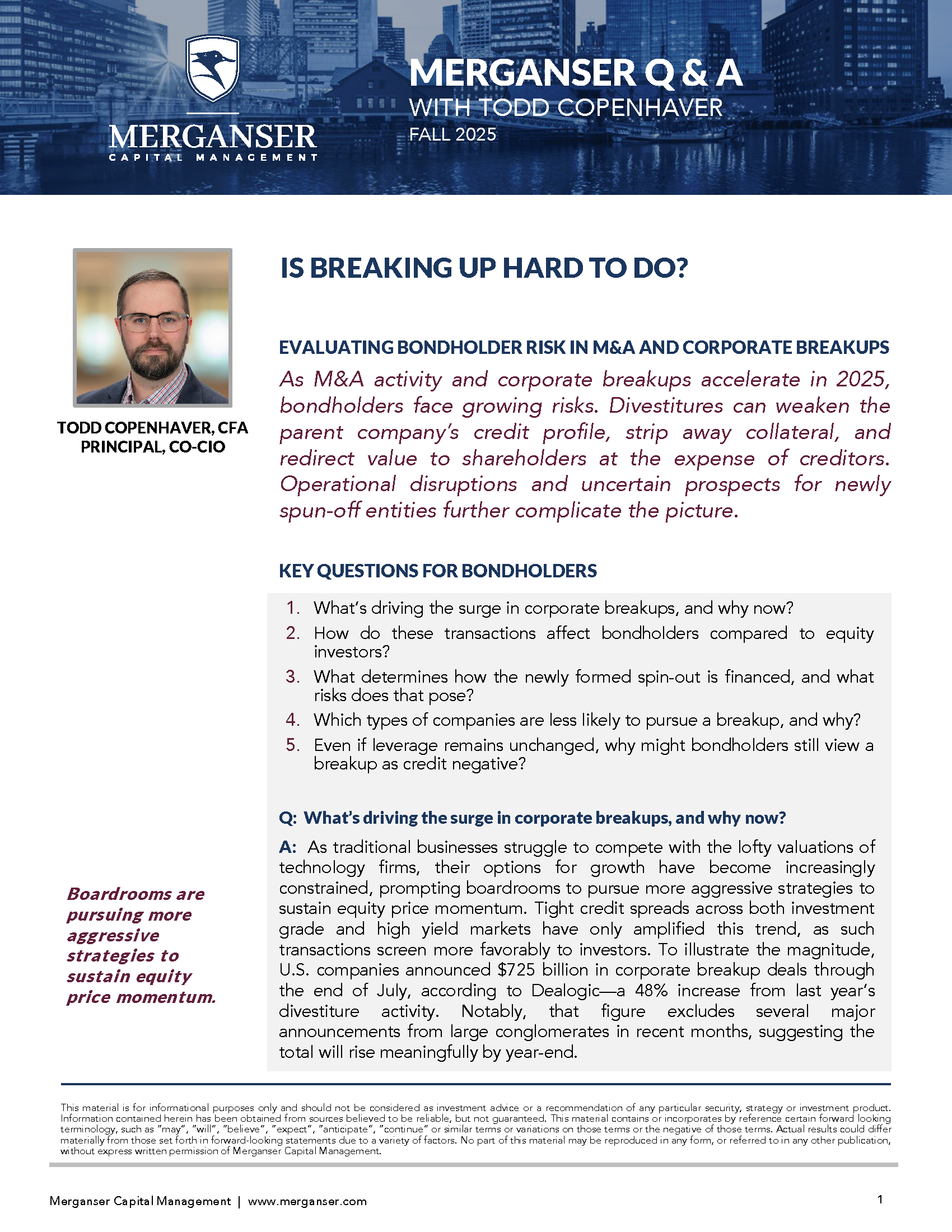EVALUATING BONDHOLDER RISK IN M&A AND CORPORATE BREAKUPS
As M&A activity and corporate breakups accelerate in 2025, bondholders face growing risks. Divestitures can weaken the parent company’s credit profile, strip away collateral, and redirect value to shareholders at the expense of creditors. Operational disruptions and uncertain prospects for newly spun-off entities further complicate the picture.
KEY QUESTIONS FOR BONDHOLDERS
- What’s driving the surge in corporate breakups, and why now?
- How do these transactions affect bondholders compared to equity investors?
- What determines how the newly formed spin-out is financed, and what risks does that pose?
- Which types of companies are less likely to pursue a breakup, and why?
- Even if leverage remains unchanged, why might bondholders still view a breakup as credit negative?
Q: What’s driving the surge in corporate breakups, and why now?
A: As traditional businesses struggle to compete with the lofty valuations of technology firms, their options for growth have become increasingly constrained, prompting boardrooms to pursue more aggressive strategies to sustain equity price momentum. Tight credit spreads across both investment grade and high yield markets have only amplified this trend, as such transactions screen more favorably to investors. To illustrate the magnitude, U.S. companies announced $725 billion in corporate breakup deals through the end of July, according to Dealogic—a 48% increase from last year’s divestiture activity. Notably, that figure excludes several major announcements from large conglomerates in recent months, suggesting the total will rise meaningfully by year-end.
Q: How do these transactions affect bondholders compared to equity investors?
A: While equity holders “own” all the economics of a breakup, investment grade bond holders are in most cases only guaranteed to be left with no less than half of the company*. Which assets and what amount of debt will remain at the legacy entity are solely at the discretion of the issuer. S&P research shows that many parent companies involved in spinoffs are later downgraded.
Q: What determines how the newly formed spin-out is financed, and what risks does that pose?
A: In most cases, the new entity issues debt to capitalize the soon-to-be independent operator, then dividends some amount of those proceeds back to the legacy entity. The use of these proceeds is often a mix between returns to shareholders and reducing the debt burden of the legacy entity, which now has the same amount of debt on a lower base of cashflow and assets. However, there is no requirement to pay down debt, and these proceeds can be solely disbursed to shareholders at management’s discretion. Because the new entity must be capitalized with fresh debt, splits often result in the new entity containing a greater proportion of higher growth and/or more attractive assets to efficiently attract new capital.
Q: Which types of companies are less likely to pursue a breakup, and why?
A: There is no panacea, but there are attributes that can make spinoffs less attractive/feasible for an issuer. Among the most effective are recent equity performance (the “if it isn’t broke, don’t fix it” defense), high levels of integration and synergy across business lines/geographies, and comparable valuation multiples across business lines/geographies.
Q: Even if leverage remains unchanged, why might bondholders still view a breakup as credit negative?
A: Even if the company maintains its credit metrics, the reduction in scale and business diversification can significantly impact the creditworthiness of the borrower (for most corporate issuers, their credit ratings are at least 20% tied to scale and business profile/diversity1). In addition, the operational and managerial challenges of separating businesses can be more complex than forecast. If weak post-spin execution raises pressure from shareholders, the now smaller legacy entity is more likely to draw the interest of private equity for a leveraged buyout.


